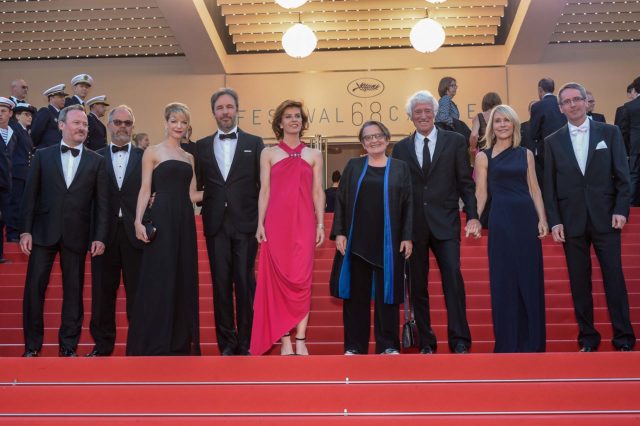
R-L: Pierre Andurand, James Deakins, Roger Deakins, Agnieszka Holland, Irène Jacob, Denis Villeneuve, Tanya Lapointe, Edward McDonnell, Claude Girard. Photo: D.Charriau
At 6:30pm Friday, May 22, Roger Deakins ascended the red carpet at Cannes, on his way to receiving the Pierre Angénieux Excellens Award for Cinematography. During the cocktail reception prior to the event, Denis Villeneuve discussed working with Roger. Denis was Director of “Sicario,” which opened at Cannes. (Variety’s Scott Foundas wrote, “Villeneuve has once again delivered an impeccably well-crafted film, not least in Deakins’ arresting lensing.”)
Jon Fauer: How is it working with Roger?
Denis Villeneuve: As with any cinematographer, it’s about creating poetry and strength in the imagery together. There’s a process of storyboarding that happens early on. There are discussions of esthetics, to find the specific alphabet of the movie. It’s a thing I was not used to doing before I worked with Roger. He taught me how useful it was and how it gives you more freedom. It’s easier to improvise on set when you storyboard the movie in advance.
Are you a technical guy as well?
I’m used to being part of the process of choosing the lenses and angles. I must say, with a regular cinematographer I’m more involved. But with Roger I trust his instinct a lot. We have a discussion. But I’m working with a master. For example, one time on “Sicario” we were working with a 32 mm lens, and I said, “Roger, I think we should go with a longer lens. I feel that the image lacks rhythm right now. It should be much more compressed.” And Roger said, “You’re totally right.” Then he called out to his camera assistant, “Bring me a 35mm lens!” I was expecting an 85 or 100 mm lens. I was laughing so much. With Roger, every millimeter has a strong effect and meaning.
How do you and Roger talk about framing and lenses choices?
Roger is first to suggest a lens. It’s a kind of dialog. It’s always in the 25 – 40 mm range, which brings a lot of intimacy and presence to the faces.
On “Sicario,” what references were used to develop the visual style?
We were inspired by the work of Alex Webb, a photographer Roger likes for his composition and use of shadows, silhouettes, and colors. We were mostly inspired by the desert. I said to Roger, “We must face the fact that we will work in harsh conditions, often with light that will make you unhappy. How could we approach that and still have pleasure even when the light is not good?” I came up with the idea that the characters would be in silhouette, walking in the desert, and we would not fight the light, but embrace it. Roger was quite stimulated by that, and we approached “Sicario” that way.
Roger is a very strong story teller. When we are designing a shot, he focuses on storytelling first and esthetics come after. I must say I had the feeling I was working with someone who saw things that other people do not see. He brings from nature and recreates nature in a very poetic and powerful way.
You’re moved the camera a lot on “Sicario.”
That is true. It works well because on “Sicario” we both had the same idea of approaching the subject with humility, trying to be authentic to the nature around us, as simply as possible. Let’s say that Roger has a strong influence on me. Before Roger, it was like a tennis game with the cinematographer. We’d throw ideas back and forth, trying to find the best place to put the camera. Sometimes it’s me, sometimes the cinematographer. With Roger, that’s not the case. Most of the time, he finds the best place.
When you work with a master, you have to be humble. I can only answer your question with humility. I’m learning on every shot. My goal is to give Roger enough “food for thought” to keep him stimulated as an artist. He needs that to be happy and keep his dynamic on set. My challenge is to inspire him.







